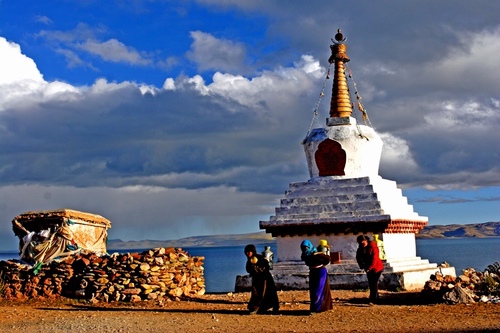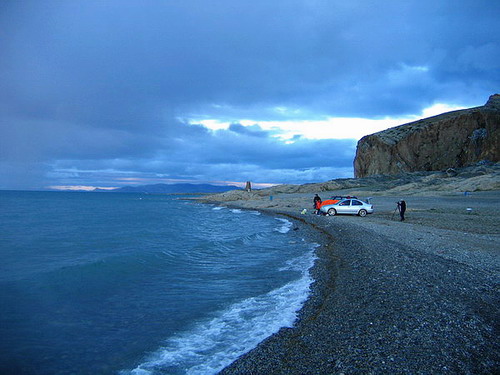Namtso Lake, China's highest saltwater lake, lies beside snow-capped Mt. located in Nagqu Prefecture, about 260 kilometers from Lhasa City and 60 kilometers from Damxung County. From Damxung to Lake Namtso, you have to drive on a gravel road and climb over a snow mountain. In the rainy season, the road, which may be destroyed the heavy rain.

ID:109452-00023 "Holy Lake": Namtso Picture Sources:ccnpic.com Zheng Xiangjie

ID:108951-00087 "Holy Lake": Namtso Picture Sources:ccnpic.com Liu Yi
Lake Namtso means “holy lake” in the Tibetan language is regarded as one of Tibetan Buddhism's three holiest lakes. The lake is a pilgrimage site for Buddhists, who consider it the seat of Paramasukha Chakrasamvara. With over 30 kilometers from north to south and over 70 kilometers from east to west, Lake Namtso covers a total area of more than 1,900 square kilometers, being the second largest salt lake in China. At an elevation of 4,718 meters, Meanwhile, it is the highest altitude saltwater lake in the world, the furthest depth being more than 33 meters. The water in the lake for the most part arises from rains, melted ice and snow of Nyenchen Tonglha Mountains and the inflow of crooks and streams, hence the lake is very clear and limpid. With the lake surface assuming sky blue, the lake and the sky seem to be one and undivided, which may make visitors feel themselves in a fairy land if they have a stroll by the lake. Namtso lake with the highest sea level in the world is far away from the pollution of modern civilization. The water here is a storybook crystal-clear blue. Clear skies join the surface of the lake in the distance, creating an integrated, scenic vista. Soul of every visitor who has ever been here seems to be cleansed by the pure lake water. The lake freezes in October. In May, the ice melts.
Namtso Lake maintains its levels from rainfall and melted snow flowing from high mountains. Five islands stand in the waters of the lake, among which the largest one is Liangduo island. In addition another five bylands stretch into the lake from different directions. Zhaxi byland is the largest in area of these five. The lake is full of islands and islets in varied forms with birds sporting over the water surface. There is a peninsula in calcareous stone southeast of the lake, called "Zhaxiduo Island", on which stands a forest of strange-shaped stones, among which occur numerous fantastic caves. Queer rocks, steep peaks, natural stone ladders and other landform wonders on Zhaxi byland present visitors a picture filled with mystery and enchantment.

ID:108951-00085 "Holy Lake": Namtso Picture Sources:ccnpic.com Liu Yi

ID:111131-00937 "Holy Lake": Namtso Picture Sources:ccnpic.com Wang Lu
Lake Namtso is also rich in its products with its gorgeous and enchanting sights. The views around Lake Namtso every evening at dusk are even more varied, beautiful and fantastic. Besides the beautiful scenery in Namtso, it is also a famous sacred Buddhist place. There is a Zhaxi Temple in Zhaxi byland. In every Tibetan year of sheep, thousands of Buddhism adherents will come here to worship. As a rule, they will walk clockwise along the Namtso Lake in order to receive the blessing of the gods.

ID:109452-00025 "Holy Lake": Namtso Picture Sources:ccnpic.com Zheng Xiangjie
Getting there: There are no direct buses to Namtso Lake. The best way is to hire a taxi or a mini bus from Lhasa.
Note: The sea level is 1100 meters (about 1203 yards) higher than that of Lhasa, therefore please bring lots of water and don't over-exert yourself. (CCNPIC Xuesen Gao)
(Article Resource: www.ccnpic.com)